W7ZOI Field Day, Ghost Ridge, Oregon, 2019
Wes Hayward, w7zoi, 28June2019
Like so many radio amateurs in North America, ARRL Field Day (FD) is
my favorite ham activity. I just can't resist the
fun of taking a rig into the field and operating
portable. My preferred FD is one where the
traditional ham activity is integrated with a hike or a backpacking
junket. I've done FD hikes for over 50 years
now. Alas, I'm now at an age where it's
harder to get out into the hills for FD. Hence, I really
wanted to get out while it's still possible, even if the hike is
tamer than those of the past.
Son Roger, ka7exm, accompanied me this year. Our
location was one of five or six earlier FDs.
Roger and I have also been there for the June VHF contest and even
the January VHF SS, the later on snowshoes.
Another time, my other son Ron, kf7hap, and I did an overnight
snowshoe trip to this place for a February contest called
"FYBO." The hike is less than 2 miles one
way. However, it does involve about 800 feet of
elevation gain, half of that off-trail. The
location is sometime called "Ghost Ridge" and other times referred
to merely as "peak 4925." It now has the
additional designator for Summits-on-the-air of
W7O/CN-086. We did not treat this trip as a SOTA
activation. The following photo shows Mt. Hood
from the top of the peak.

Roger and I debated. Should this be a backpacking
overnight effort, or merely a one day walk? We finally
decided on a day hike, for there was no snow on peak 4925 this year
to provide water.
We set up our operating position about 100 feet from the summit
where available trees could support an antenna. A
fan dipole for 40 and 20 meters was installed as an inverted
Vee. Two lines were hoisted into a couple of the alpine fir
trees and were set up to support the center of the antenna and the
feedline, a piece of RG-58A/U. The 40 and 20 meter
dipole sections were then staked out with light weight
cord. The two bands were separated to minimize detuning
one with the other. The antenna is shown below.

The operating position is shown below. We used my
Elecraft KX2 for this effort, operating at 4 watts
output. A homebrew transmatch was
used.
 A
small clip board had an attached keyer paddle in a
corner. Roger used a larger clip board for cross check
sheets. Our operating was on 40, 20, and 15 meter
CW, with most activity on 40. 15 meters surprised us
with unexpected activity. We never did
operate any SSB. I suppose I'll have to give it a
try some time.
A
small clip board had an attached keyer paddle in a
corner. Roger used a larger clip board for cross check
sheets. Our operating was on 40, 20, and 15 meter
CW, with most activity on 40. 15 meters surprised us
with unexpected activity. We never did
operate any SSB. I suppose I'll have to give it a
try some time.
We operated for about two and a half hours. About
half way through the afternoon, we took a break for a trip to the
peak of the hill. The views were just too good to
pass up. We have operated from the very peak for some
other contests such as VHF events where a higher, in-the-clear
location is useful. But comfortable operating positions
are missing on the top. The photos below show
Roger and me.
 ka7exm
ka7exm  w7zoi
w7zoi
The conditions were poor, but the bands were quiet from the hill
top. We seemed to have no trouble in making
contacts on any of the bands and never found a need to break out a
battery other than the one internal to the KX2.
Battery technology has certainly evolved in recent
times. The fan dipole was effective, but a
bit messy and time consuming to put up. I'm
thinking that a 50 ft dipole might be a good bet for next
year. No matter what we do, this trek was
great fun. Thanks for an excellent trip Rog.
Click here to
see descriptions of other portable treks with amateur radio,
including numerous Field Days.


 A
small clip board had an attached keyer paddle in a
corner. Roger used a larger clip board for cross check
sheets. Our operating was on 40, 20, and 15 meter
CW, with most activity on 40. 15 meters surprised us
with unexpected activity. We never did
operate any SSB. I suppose I'll have to give it a
try some time.
A
small clip board had an attached keyer paddle in a
corner. Roger used a larger clip board for cross check
sheets. Our operating was on 40, 20, and 15 meter
CW, with most activity on 40. 15 meters surprised us
with unexpected activity. We never did
operate any SSB. I suppose I'll have to give it a
try some time. ka7exm
ka7exm  w7zoi
w7zoi